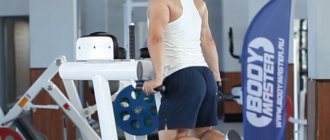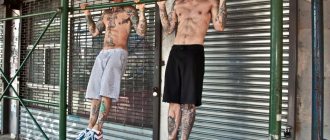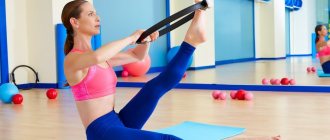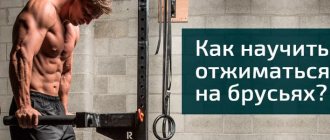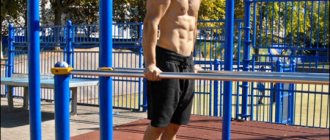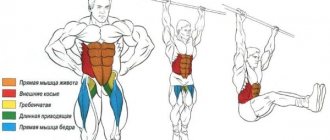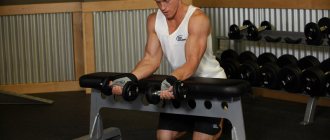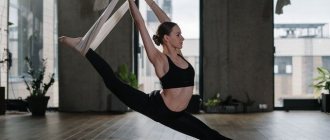Exercises on the uneven bars are included in the training program by both professional and amateur athletes. This sports equipment is very popular among athletes for a reason. Regular exercises help pump up: deltoids of the shoulder girdle and triceps, which are quite difficult to give relief with the help of other types of strength training.
This simulator, familiar to everyone since childhood, allows you to achieve impressive results. It should be understood that it will not be easy for an unprepared person to practice it. When including exercises in your training regimen for the first time, carefully monitor your condition. Avoid overloading to avoid tearing your muscles. Otherwise, you will have to take a long break to fully recover.
What muscles work when exercising on parallel bars?
The uniqueness and high effectiveness of strength exercises on the uneven bars lies in the fact that the athlete can independently change the target muscle group by adjusting the execution technique.
Depending on the technique chosen, the athlete can work the triceps or pectoral muscles. In addition, the back and synergistic muscles are actively involved in the work - muscles that are involved in the work together with the main muscle group being trained.
It is noteworthy that the triceps experience stress in any case, regardless of how you do push-ups. Just to a greater or lesser extent. The chest muscles, at the same time, always take on part of the work. That is, in order to work a specific muscle group, it is necessary to perform movements in strict accordance with a specific technique.
So, while practicing on the uneven bars, you can train:
- triceps;
- pectoralis major muscles;
- anterior deltoid;
- ligaments of the elbow, wrist and shoulder joints;
- back muscles;
- rectus, transverse, external and internal abdominal muscles (abs);
- When bending your legs back, the buttocks and biceps of the thigh are included in the work.
Types of grips
Shoulder exercises on the horizontal bar and parallel bars include several types of grip:
| Grip type | Description |
| Lock | They clasp the crossbar with their hands and clasp their hands together. |
| Wide | During training, the load is evenly distributed on the back, shoulders and chest. Your arms should be slightly wider than shoulder-width apart. |
| Synchronous | When performing exercises, the trapezius, rear delta, rhomboid muscle, and shoulder girdle work. The hands must be positioned shoulder width apart. |
| Narrow | The grip can be opposite, reverse or straight. During the training, the teres minor and major, subscapularis and brachialis muscles are worked out. The brushes are placed at a distance of 12-17 cm from each other. |
| Various | Hands are placed with a reverse and direct grip. During the exercises, the position is changed to ensure an even load on the shoulders. |
| Back | The horizontal bar is clasped so that the fingers are directed towards the girl’s face. During the exercises, you must ensure that the shoulder girdle is not overloaded. |
| Straight | Hands are positioned away from the face. During classes, the back muscles are worked. |
If a girl trains on the uneven bars, then she should place her hands with a direct grip. Otherwise, it will be impossible to complete the exercises.
How to properly train on parallel bars
Bars, like any other sports equipment, require compliance with certain rules. These settings are not particularly complicated, but it is necessary to adhere to them so as not to harm yourself during training.
- All movements during the parallel bars exercise program should be smooth. When doing push-ups, you should lower yourself down carefully, avoiding jerking. When working your abdominal muscles, you also need to act carefully, smoothly lowering and raising your legs.
- Don't forget that sudden, inept movements are the most common cause of injury.
- For push-ups, it is best to use parallel or angular machines. The second option is more versatile, as it allows you to adjust the grip width.
- When pumping your chest muscles, do not spread your elbows too wide. An angle of 45 degrees is considered optimal.
- When making a downward movement, do not go down too deep. The stretch should be noticeable, but not excessive. Many novice athletes try to extend their arms as much as possible, which often leads to damage and inflammation of the joints.
Execution Rules
Before you start practicing on the uneven bars, be sure to warm up your muscles well, this will reduce the risk of injury. Perform the exercise slowly, controlling and stabilizing your body through your core muscles. Don't move your head, legs or swing your body in an attempt to help yourself pull yourself up.
Push-ups should be started from the top point. The body weight must be transferred to the arms. Your back should be straight and your shoulders should be pulled back. You need to lower yourself very slowly, leaning your body forward and maintaining tension in your muscles. Then you can fixate for a short time at the lowest point. The angle at the elbow should be maintained within 90 degrees. You need to rise just as smoothly and under control. Particular attention should be paid to breathing: inhale when lowering, and exhale when ascending.
Varieties of exercises on parallel bars
There are not many exercises that can be performed using parallel bars. Moreover, most of them are aimed at working the muscles of the chest and triceps. Push-ups are especially common, they are among the basic ones and are the most effective.
Universal push-ups
Take the starting position on the apparatus with straightened arms. In the upper position, try not to bend over, keep your legs crossed or simply connect them together.
As you inhale, gently bend your elbows and gently lower yourself down as far as possible. Ideally, your hands should be at the same level as your armpits. In the lower position, hold for 2-3 seconds and, as you exhale, “throw” your body up, again rising to straight arms. When performing the movement, try not to sway or move your legs back.
Push-ups for training the pectoral muscles
To set the load on the chest muscles, it is necessary to select a projectile with a wider distance between the bars. The more the shoulders are pulled away from the body, the more the pectoral muscles are involved in the work.
Jump onto the apparatus, take the starting position with straight arms. Exhaling, slowly lower yourself down. About halfway through the movement, spread your elbows to the sides, and almost at the bottom point, bend forward. As you exhale, return to the starting position, lifting your body by contracting your pectoral muscles.
Push-ups with emphasis on triceps
This is an ideal parallel bars exercise for beginners as it is technically easier to perform. Triceps push-ups are more natural for beginner athletes with poorly developed neuromuscular connections.
Unlike the previous option, to perform it you have to select a projectile with a small distance between the crossbars. There is no need to spread your elbows; on the contrary, press them close to your body. At the same time, keep your body perpendicular to the floor surface/ground (do not lean forward).
When descending, do not try to reach the lowest possible point. It is enough to bend your elbow joints to a right angle. When taking the top position, do not straighten your elbows completely. Otherwise, the main load will not be on the triceps, but on the joints and ligaments. Which in itself is very traumatic, especially when working with weights.
Pronated grip push-ups
This exercise is performed in the same way as triceps push-ups. There is no need to go down too deep and lean forward. The main difference is that when placing your palms on the apparatus, you should turn them away from you (the effect of inverted hands). This position allows you to achieve maximum load on the triceps.
Horizontal push-ups (lying on parallel bars)
This movement is very similar to regular push-ups. Only in this option will it be possible to lower the chest below the level of the palms, which will allow you to place a greater load on the triceps and pectoral muscles.
You have to do push-ups “lying” on the apparatus, resting your toes on the bars. Take the starting position, press your elbows to your body. As you inhale, slowly lower yourself down, trying to keep your chest below the level of your palms. Exhaling, return to the starting position.
Walking on your hands
The essence of this exercise is to take the upper position on the apparatus and move along the entire length, moving your hands. Accordingly, for execution it is necessary to select bars of the appropriate size. Depending on the width of the “step”, the depth of flexion of the elbow joints and the tilt of the body, various muscle groups are worked out. But no matter how you walk, in any case the muscles of the shoulder girdle, back, and forearms will be subject to stress.
Abdominal muscle training
When performing any type of push-ups, the athlete's body remains almost static. All dynamics are focused on the work of the arms and shoulder girdle. But, in order to pump up the abs with the help of parallel bars, you have to use the lower part of the body, leaving the upper limbs motionless. Among the common schemes for training the abdominal muscles:
- Straight leg raise. Allows you to work out the muscles of the lower abs.
Take the top position on the apparatus. Keep your back straight, do not lean forward. Stretch your legs and bring them together. Now slowly raise them to the level of the crossbars and also slowly lower them. When performing this exercise, try to exclude any other movements.
- Raising bent legs. The lower abdominal muscles are also involved here, but the back and hips are also involved in the work.
A simplified version of the previous exercise. While in the starting (top) position, bend your knees and pull your legs as close to your body as possible.
Interesting facts and observations
Multiple Olympia champion Jay Cutler came up with a special version of the exercise in which the triceps are used to the fullest. He works in V-shaped bars with his back to the apparatus. This allows even with a wide back and massive arms. Cutler recommends partial repetitions for this exercise, especially if the lifter is lifting a significant amount of weight. He considers the full amplitude to be traumatic.
Parallel bars training program
To work out all muscle groups, you need to choose the optimal training regimen for yourself. So, for example, you can use the following training scheme:
- Warm up - 5 minutes.
- Bent leg raises - 10 reps.
- Push-ups on the chest - 12-15 times.
- Universal press - 10-12 repetitions.
- Triceps push-ups - 10-12 reps.
- Pronated grip - 8-10 times.
- Horizontal press - 10-12 repetitions.
- Straight leg raises - 8 reps.
- Walking on parallel bars - all the way.
- Hitch.
Depending on your physical fitness, you can do 1-3 approaches. It is recommended to rest no more than 1 minute between sets. For greater effectiveness, sports trainers advise alternating exercises on parallel bars and horizontal bars.
For newbies
Most women, as well as beginner athletes, have insufficiently developed chest, arm and back muscles. As a result, the parallel bars press will not be performed fully. Accordingly, many people have a question: how to learn to do push-ups on uneven bars from scratch? We suggest using the following recommendations:
- Start training in the gravitron. This machine makes it much easier to perform exercises due to its counterweight.
- Strengthen your muscles with other exercises. Perform various types of push-ups, bench presses, and bench presses.
- In the initial stages, try doing push-ups using partial amplitude, increasing over time and bringing it closer to the normal position.
- To establish good technique and practice correctly in the future, use the help of a trainer.
- First, learn how to do negative push-ups. In them, the main emphasis is on the slow descent of the body, rather than on the rise. By exercising in the negative phase, you can increase the effectiveness of your training and develop muscle strength.
Common Mistakes
Many beginners and even experienced athletes make mistakes during training. The most typical of them should be listed:
- Some athletes spoil the effect of training by taking the wrong starting position (excessively wide grip). As a result, the load on the deltas increases greatly, which can ultimately lead to injury.
- Failure to comply with breathing rules during training. The downward movement should be done while inhaling, the lifting should be done while exhaling.
- Execution too fast. When including dips in your program, forget about speed and sudden jerks. Your actions should be smooth.
- Excessive use of additional burdens and untimely implementation. Don't use too much weight. Add it gradually, only when you can complete 3 sets of 20 repetitions with the current one.
Warm-up
Muscles must be warmed up to reduce the risk of injury and the danger of a sharp jump in blood pressure.
The universal warm-up scheme looks like this:
- cardio warm-up – 1-1.5 minutes;
- gymnastics for joints – 1-2 minutes;
- muscle stretching – 2-2.5 minutes;
- cardio warm-up – 2-3 minutes;
- recovery of breathing – 1 minute.
Similar exercises can be done after training to relieve muscle tension and circulate blood throughout the body.
The most effective warm-up exercises:
- Walking with knees raised.
- Buckles are in place.
- Jumping rope.
- Run in place.
- Squats.
- Lunges.
However, it is necessary to take into account that before starting training on the uneven bars, you need to do a special warm-up.
To prepare your body, you need to do some handstands on the uneven bars. At first this may be difficult, but then, as your muscles grow, maintaining your weight will be much easier.
Before you start pumping up your abs, you need to find out how long you can hang on the horizontal bar or parallel bars - in other words, how strong your arms are.
Ideally, you should do some push-ups on the parallel bars before training.
By nature, the female body has a small percentage of muscle tissue, so it will take several weeks to learn how to warm up on the uneven bars.
Only after this can you move on to the main exercises. If your arms are weak, you can easily get injured - a dislocation or sprain.
Therefore, you should not exaggerate your capabilities and immediately move on to a complex set of exercises.
Tips for beginners
- Don't round your back. Even when leaning forward, it should remain straight.
- Do not bend your wrist and elbow joints.
- The width of the apparatus should be matched to the width of the athlete’s shoulders.
- Do not jump off the apparatus on straight legs, but carefully descend from it so as not to injure your spine.
- Do not use unstable or broken equipment for training.
- Be sure to warm up before performing the main program.
- Supplement your exercise with proper nutrition to achieve better results.
- Carefully follow all stages of the exercise. Don't stay too long in the bottom or top position.
- Make sure that your movements are measured, without jerking or haste.
Graduation of athletes by age
In the uneven bars section of artistic gymnastics, the following age categories are distinguished:
- Children (6–8 years for girls, 7–10 years for boys);
- Girls up to 12 years old, and boys up to 13 years old;
- Juniors (14–17 years old for males, 13–15 years old for females);
- Adults (women over 16 years old, men over 18 years old).
In some cases, the age category for juniors and juniors is stated to be up to 25 years old. An athlete's career begins with the first youth sports category. You can become a master of sports in this area from the age of 14 for girls, and from 16 for boys.
Read also
- How to pump up your arms at home - training your arms at home
- Exercises with an elastic band for the back are the most effective exercises for a healthy spine and lower back.
- Back exercises at home. 8 most effective
- Posture exercises – a set of exercises for a healthy back
- Triceps exercises with dumbbells
Costume requirements
Athletes are required to perform in gymnastics costumes. For men, this is gymnastics tights and a T-shirt. Women perform in gymnastic leotards or overalls. At the request of the participant, the swimsuit can be with or without sleeves. It is allowed to wear leggings that match the color of the swimsuit.
For shoes, gymnasts wear socks or slippers. If athletes perform as a team, then their gymnastic costumes must be the same.
Judging system
The competition participants are assessed by a panel of judges (GC), which consists of the chief judge, judges of teams D and E, and assistant judges. The main panel of judges is formed by the federation that organizes the event.
The chief judge organizes the preparation of the competition site, equipment, reviews applications from athletes, and holds organizational meetings before the competition. He also checks how well trained doctors are, controls the availability of places for reporters, and prepares a report to the organization under whose auspices the event is being held. His deputy forms judicial teams and exercises control over them.
The chief secretary and his deputy are involved in drawing up documentation, checking protocols, and maintaining a table of gymnasts’ results. The secretary prepares lists of participants, issues them numbers, and contacts the press center.
Judging panel D consists of two people. They evaluate how difficult the gymnast performed an element and enter the final result into the computer. According to the rules, jury members have the right to deliberate among themselves. If they cannot come to a common opinion, they turn to the appeal commission for an independent assessment. The judges set certain requirements for the compositions and add points for connections.
Judging Panel E consists of five jury members. They are responsible for assessing artistry and identifying mistakes that were made by the gymnast while performing combinations, and keeping a record of all exercises. It is their scores that are the basis for summing up the final result.
Assistant judges are appointed during the draw. This group includes judges:
- timekeepers;
- those responsible for musical accompaniment;
- informants;
- with the participants.
It is worth noting that no less requirements are imposed on the selection of judges than on the participants. A judge may be rewarded for a job done competently, but if they perform their duties incompetently, they may be fined or even deprived of their judicial license.
Grading system
For each discipline in gymnastics, there are two grade options: D and E. The first is given for the content of the element being presented, and the second is for the overall composition, performance technique, and the ability to present oneself during a performance.
Judges evaluate participants using a ten-point system, with deductions and bonuses in the form of tenths of one point allowed. To arrive at the final score, the jury members add up the scores of the D and E judges and then apply deductions.
Books
There are few books about artistic gymnastics, but enough to highlight interesting publications worthy of attention.
- Author: Gaverdovsky Yu. “Gymnastic all-around.” This 1987 textbook remains one of the best today. It contains up-to-date information about exercises from both men's and women's disciplines. The publication is suitable not only for beginner gymnasts, but also for accomplished athletes. The training manual describes in detail the technique of performing the most complex gymnastic elements and their combinations. For clarity, the book contains diagrams and pictures.
- Author: Menkhin Yu. “Physical training in gymnastics.” Before competing at international competitions, an athlete goes through a long journey: he engages in grueling training and hones his skills in gymnastic elements. In this publication, the author describes in detail what you need to pay attention to when physically training gymnasts of one discipline or another. Menkhin examines in detail the issues of organizing training at home and in the gym.
- Author: Douglas G. "Raising the Bar." The two-time Olympic champion published a series of books in which she shared her own experience of participating in artistic gymnastics competitions. This is not a textbook, but a story about the behind-the-scenes life of an athlete, everyday training. The author not only talks about personal things, shares photographs, but also gives a lot of valuable advice on how to achieve your goals.
Bars are a spectacular, but at the same time difficult sport. The discipline requires the athlete to have excellent physical fitness and the ability to feel his body. As you know, to achieve good results in any sport, persistent regular training is necessary.
Federation
The International Gymnastics Federation (IFG) is the most important organization preparing global sporting events and developing performance rules. The Federation organizes competitions in several gymnastic disciplines, including uneven bars. It is worth noting a number of additional areas of work of the federation in addition to artistic gymnastics - these are rhythmic gymnastics, sports aerobics and acrobatics, trampolining.
The European Gymnastics Union was founded in the 80s of the last century, unites federations of European countries (48 organizations in total), and represents the interests of the states of this continent at international competitions. Engaged in the preparation of competitions in artistic and rhythmic gymnastics.
The Russian Artistic Gymnastics Federation was founded in 1991 and unites federations from more than 70 regions of Russia. The organization coordinates the development of this sport in our country, assists in creating conditions for the popularization and accessibility of artistic gymnastics among children and adolescents, and strengthens the prestige of our gymnasts on the world stage.

